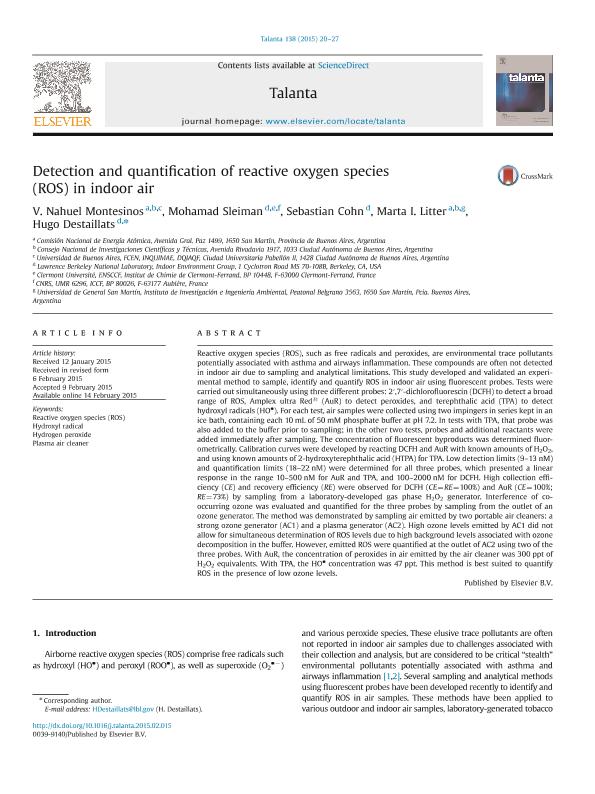Artículo
Detection and quantification of reactive oxygen species (ROS) in indoor air
Montesinos, Victor Nahuel ; Sleiman, Mohamad; Cohn, Sebastian; Litter, Marta Irene
; Sleiman, Mohamad; Cohn, Sebastian; Litter, Marta Irene ; Destaillats, Hugo
; Destaillats, Hugo
 ; Sleiman, Mohamad; Cohn, Sebastian; Litter, Marta Irene
; Sleiman, Mohamad; Cohn, Sebastian; Litter, Marta Irene ; Destaillats, Hugo
; Destaillats, Hugo
Fecha de publicación:
06/2015
Editorial:
Elsevier Science
Revista:
Talanta
ISSN:
0039-9140
Idioma:
Inglés
Tipo de recurso:
Artículo publicado
Clasificación temática:
Resumen
Reactive oxygen species (ROS), such as free radicals and peroxides, are environmental trace pollutants potentially associated with asthma and airways inflammation. These compounds are often not detected in indoor air due to sampling and analytical limitations. This study developed and validated an experimental method to sample, identify and quantify ROS in indoor air using fluorescent probes. Tests were carried out simultaneously using three different probes: 2′,7′-dichlorofluorescin (DCFH) to detect a broad range of ROS, Amplex ultra Red® (AuR) to detect peroxides, and terephthalic acid (TPA) to detect hydroxyl radicals (HO•). For each test, air samples were collected using two impingers in series kept in an ice bath, containing each 10 mL of 50 mM phosphate buffer at pH 7.2. In tests with TPA, that probe was also added to the buffer prior to sampling; in the other two tests, probes and additional reactants were added immediately after sampling. The concentration of fluorescent byproducts was determined fluorometrically. Calibration curves were developed by reacting DCFH and AuR with known amounts of H2O2, and using known amounts of 2-hydroxyterephthalic acid (HTPA) for TPA. Low detection limits (9-13 nM) and quantification limits (18-22 nM) were determined for all three probes, which presented a linear response in the range 10-500 nM for AuR and TPA, and 100-2000 nM for DCFH. High collection efficiency (CE) and recovery efficiency (RE) were observed for DCFH (CE=RE=100%) and AuR (CE=100%; RE=73%) by sampling from a laboratory-developed gas phase H2O2 generator. Interference of co-occurring ozone was evaluated and quantified for the three probes by sampling from the outlet of an ozone generator. The method was demonstrated by sampling air emitted by two portable air cleaners: a strong ozone generator (AC1) and a plasma generator (AC2). High ozone levels emitted by AC1 did not allow for simultaneous determination of ROS levels due to high background levels associated with ozone decomposition in the buffer. However, emitted ROS were quantified at the outlet of AC2 using two of the three probes. With AuR, the concentration of peroxides in air emitted by the air cleaner was 300 ppt of H2O2 equivalents. With TPA, the HO• concentration was 47 ppt. This method is best suited to quantify ROS in the presence of low ozone levels.
Archivos asociados
Licencia
Identificadores
Colecciones
Articulos(SEDE CENTRAL)
Articulos de SEDE CENTRAL
Articulos de SEDE CENTRAL
Citación
Montesinos, Victor Nahuel; Sleiman, Mohamad ; Cohn, Sebastian ; Litter, Marta Irene; Destaillats, Hugo; Detection and quantification of reactive oxygen species (ROS) in indoor air; Elsevier Science; Talanta; 138; 6-2015; 20-27
Compartir
Altmétricas



